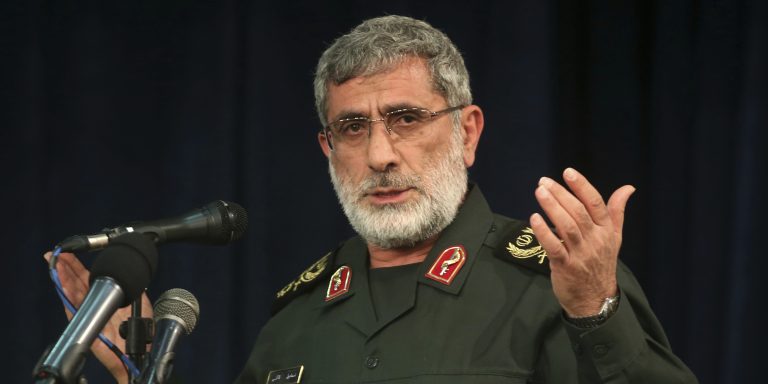INTELBRIEF
January 23, 2020
IntelBrief: Can Esmail Qaani Lead Iran’s Islamic Revolutionary Guard Corps – Qods Force?

- The operations of Iran’s Islamic Revolutionary Guard Corps – Qods Force (IRGC-QF) will continue unabated despite the death of its commander Qasem Soleimani.
- His successor, Esmail Qaani, has intimate familiarity with all Qods Force operations but lacks Soleimani’s independent channel to Iran’s Supreme Leader.
- The IRGC-QF’s concentration post-Soleimani will be on trying to achieve the termination of the U.S. military presence in Iraq.
- The Qods Force is likely to expand its ranks and operations as it seeks to avenge Soleimani’s killing and extend Iranian influence.
.
The January 2, 2020 U.S. strike that killed IRGC-QF commander Qasem Soleimani has prompted debate over the future of the Qods Force’s capabilities and operations. Soleimani was without question the most charismatic and perhaps most effective of the Qods force’s commanders, but he was not its founder nor even the only Qods Force commander to have registered successes in implementing Iranian foreign policy. The unit evolved from the IRGC expeditionary force that deployed to Lebanon in 1982, after the Israeli invasion of Lebanon, to help organize the Shia militant elements that formed Hezbollah’s military wing. It should be no surprise that Iran’s policy of building up regional armed factions into significant armed political movements was a strategy set in place from the earliest days of the Iranian Islamic regime – long before Soleimani became commander of the Qods Force. With training and other assistance from the IRGC, Hezbollah evolved as a significant movement in Lebanon while Soleimani was still a minor IRGC ground commander fighting a Kurdish insurrection against the nascent Iranian regime. Soleimani’s predecessor as Qods Force commander, Ahmad Vahidi, was responsible for the operation to bomb Israel’s embassy in Buenos Aires, Argentina in 1992, as well as for the bombing of a Jewish cultural center in the same city two years later. Iran considered these terrorist attacks major successes in what has become an existential conflict between Iran and Israel. Soleimani was also a minor IRGC figure as Iran turned Iraqi Shia prisoners captured in the 1980-88 Iran-Iraq war into armed insurgents who would play a major role in Iraqi politics after the fall of Saddam Hussein following U.S. intervention in Iraq in 2003.
Soleimani was able to build on these early successes when the IRGC, in 1997, promoted him from operations along the tense border with Taliban-controlled Afghanistan to commander of the IRGC-QF. Esmail Qaani was appointed deputy IRGC-QF commander simultaneous with Soleimani’s promotion, and Qaani served as Soleimani’s most trusted and effective lieutenant thereafter. Qaani generally lacks the charisma of Soleimani – a trait which helped Soleimani develop a direct channel to Supreme Leader Ali Khamene’I and bypass the formal chain of command. Qaani was nonetheless instrumental in Soleimani’s successes; it was Qaani, whose main area of responsibility was the areas east of Iran, who implemented the bold and successful plan of recruiting Afghan and Pakistani Shias to travel to Syria to fight on behalf of the regime of President Bashar Al Assad. Soleimani’s independence also occasionally caused some unrest that Qaani is likely to avoid. For example, in early 2019, Soleimani’s exclusion of Foreign Minister Mohammad Javad Zarif to a meeting with the visiting Assad caused a dispute with Zarif and Zarif’s main ally, President Hassan Rouhani.
As Qaani seeks to meet the high expectations set for any Qods Force commander, his immediate tasks are clear. He has vowed to avenge Soleimani by driving U.S. forces from the Middle East, and nowhere is the Qods Force closer to achieving that objective than in neighboring Iraq. There, the Qods Force is activating its several Shia militia proxies to use their political leverage to compel Iraq’s leadership to request that the 5,200 U.S. forces leave the country. U.S. officials, realizing that being expelled from Iraq would virtually cede the country to Iranian control and set back U.S. efforts to prevent a resurgence by the so-called Islamic State, are threatening significant sanctions and other penalties if Iraq’s government ends the U.S. mission there.
The regime undoubtedly recognizes that Qaani and his team will require ample resources to fulfill their ambitious goals. According to the 2019 military power of Iran report prepared by the Defense Intelligence Agency, the Qods Force has about 5,000 personnel in its ranks. It is likely that it will recruit additional personnel from the other IRGC services, the Ministry of Intelligence, and other Iranian institutions to evaluate new opportunities to pressure U.S. forces, U.S. diplomats, and U.S. allies in the region and worldwide. The emotional outpouring at Soleimani’s funeral suggests that the Qods Force might have a large pool of new volunteers to recruit from. An expansion of the IRGC-QF will position the force to evaluate a larger universe of potential targets and plan a wider range of operations aimed at denying U.S. and U.S. allied forces the access and security needed to operate in the region.
.
For tailored research and analysis, please contact: info@thesoufancenter.org